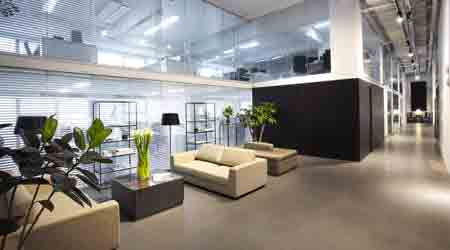Benefits of Office Design for Employee Performance
First of a 4-part article on how to improve the physical work environment to increase employee satisfaction and productivity
It seems intuitive that comfortable office workers would be productive workers. While proving that point has been notoriously difficult, evidence continues to emerge that temperature, lighting, furniture, and layout can be used to help a company improve employee performance.
“If employees are more comfortable, they’re able to focus more on work” and not on cold hands or glare, says Judith Heerwagen, a research psychologist with the Office of Federal High-Performance Green Buildings in the federal General Services Administration. She cited research by the National Institutes of Health that measured workers’ heart rates and cortisol levels in pre- and post-renovation spaces and found correlations to levels of noise, light, and views. In better spaces, both heart rates and cortisol levels were lower. (Cortisol is sometimes known as “the stress hormone.” Ongoing elevated levels of cortisol are linked to health problems.)
David Lehrer of the Center for the Built Environment points out that productivity can be measured in different ways. Depending on the situation, it might be easier or more relevant to look at individual workers, or a team, or the company. Lehrer’s organization surveys workers by asking them whether various factors in an office setting enhance productivity, hurt it, or are neutral. A further refinement is to ask workers via email or text message how they feel at that moment.
Controllability and Comfort
In addition to subjective surveys about how workers feel, environments can be measured through parameters such as typing speed, or by collecting biometric data. Recent studies, for instance, have shown weight loss and improved blood cholesterol in workers who use adjustable-height desks.
“The majority of our clients are now buying adjustable-height desks for every work station,” says Janet Morra, a principal at Margulies Peruzzi Architects in Boston. The cost difference with conventional desks is dropping, and in any case is “quickly made up in comfort and productivity,” she says. Instead of walking around, “people can take breaks by standing up or sitting down.”
An often-repeated phrase is “sitting is the new smoking,” but standing for eight hours in the same position would be just as bad. Variability and control of the work environment are important components of comfort. The most important thing managers can do, Heerwagen says, is to let workers control their workspace in whatever ways possible.
This has already been adopted in the lighting world, which has seen an explosion of innovation in recent years and is one of the easiest changes to make in an existing building. Alan Hedge, director of the human factors and ergonomics laboratory at Cornell University, says indirect, glare-free lighting can combine with task lights at desks that workers control; generally, people in their 40s and older will need more concentrated light than their younger counterparts.
Good communication is critical to executing solutions focused on improving the office environment since so many factors interplay. To create a comfortable, productive environment, the most important factor is “the way the organization itself is organized and run,” says Heerwagen. Executives who manage space and who manage people need to communicate well, “and it’s often not done.” She cites a case in which architects and lighting designers worked together to maximize daylight in an office, but the effort was undone because the furniture blocked the light; the supplier had not been in on the discussions.
Similarly, “nothing frustrates tenants more than lack of information,” says Kevin Kampschroer, GSA’s chief sustainability officer.
Related Topics:















